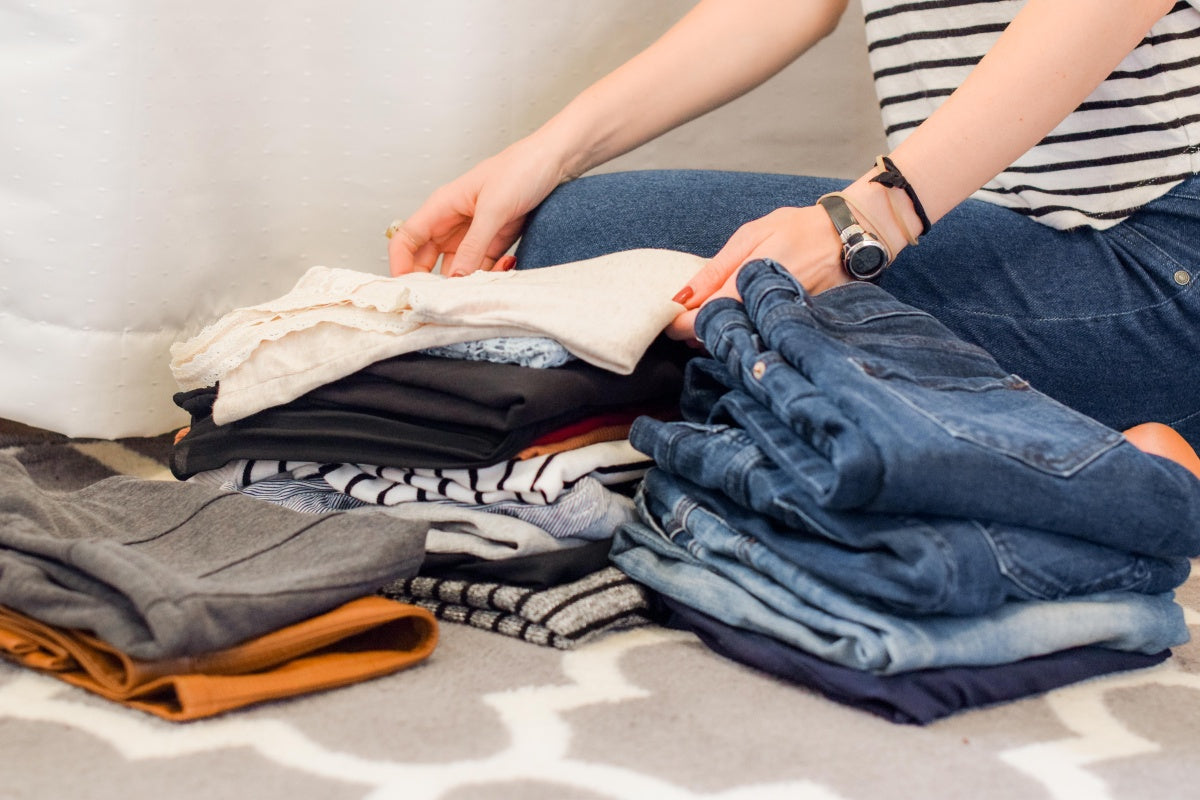
7 Tips on How to Store Clothes Long Term
When attempting to store your clothes long term, it can be difficult to know where to start. Not only do you have to pick and choose your clothes for the right season, you have to consider if you’re going to donate any, how to pack them and so much more. That’s why we’ve decided to make it easy for you, and give you step by step tips on the best ways to store clothes over long periods of time.
1. Keep, Sell, Reuse or Donate
Before you even begin to think about washing and packing your clothes for storage, it’s time to think about removing any that you don’t need (otherwise you’ll be making extra work for yourself further down the line). An excellent method of removing clothes you don’t need is by sorting them into four different categories: keep, sell, reuse or donate.
Keep
Use your keep category for all the clothes you want to keep for regular use in the future, and set these aside for long term storage. If you're storing clothes because the seasons are changing, think about what clothes you might need for the entirety of the time. For example, if you’re storing your autumn/winter clothes, you may still need a coat to account for a rainy day.
Sell
You may have some clothes that are in quality condition that you don’t want to keep – maybe they don’t fit anymore or you’ve changed your style. These are the best to type to sell. You could sell them online, on an app or even at a car boot sale.
Reuse
Reusing or upcycling is the best way to repurpose your clothes, giving them a new lease of life. You could upcycle a dress into a t-shirt, or if you’re not sewing savvy you could use the fabric as dusting cloths. Either way, there’s lots of room to get creative with it!
Donate
Your unwanted clothes can be very valuable to those in need. You can donate to a local charity shop, a national charity such as the Salvation Army, or to a specific local cause such as a children’s hospital or homeless shelter.
2. Wash and dry your clothes
Before you think about how to store your clothes, you should wash and dry them correctly. By cleaning any stains, washing your clothes and drying them thoroughly, you’ll be giving them the best chance at being in pristine condition by the time they come out from storage.
Food stains, like a splash of wine or even a few crumbs, will only get worse the longer that you leave them. It’s also likely that they’ll encourage unwanted visitors such as mice towards your stored clothes. The best way to store clothes is at their freshest possible, so they’ll remain undisturbed and be equally as attractive as when you put them in.
You may want to get them dry cleaned, however we’d recommend that you don’t iron them as you or your dry cleaner will only have to iron them when they come out of storage again.
3. Do damage control
When storing clothes it’s best to limit any damage to the clothing, both before and during the time they spend there.
Fix any damaged clothes prior to storage
Anything you’re planning to keep should be thoroughly inspected for damages, such as a tear in the seam or a missing button. Make sure you repair these so they look as good as new when they come out of storage.
Wash, dry and store with with caution
Cleaning and drying your clothes involves a lot more than just loading them in the washing machine and pressing start. Pay close attention to the care label, always try to air dry rather than tumble dry and use gentle detergents to prevent any damage or fading. Any poor handling of clothes through the washing process will only be emphasised whilst they’re in long term storage.
Store in a dark, cool and dry location
Bright sunlight and high temperatures are the easiest way to damage your clothes in storage. Direct sunlight can cause your clothes to fade and high temperatures can warp or even melt certain fabrics, therefore choosing a spot that’s dark and below a temperature of 23°C is ideal. If your current choice of storage location isn’t suitable, a container storage unit with all the right requirements might be the best option for you.
4. Choose the best storage containers
There are many container options available for storing your clothes, including vacuum bags, fabric bags, cardboard boxes and plastic containers. Let’s have a look at what’s best.
Don’t choose cardboard or vacuum sealed containers
We don’t recommend storing your clothes long-term in cardboard boxes or vacuum sealed bags. Cardboard boxes are offer no moisture protection; vacuum sealed bags, although space saving, can cause damage to delicate or natural fibres, eventually leading to them losing their shape.
Plastic containers keep clothes damage free
Plastic-lidded containers are the best way to store clothes long term as they keep your clothes dry, mould free and secured. If you have any particularly delicate items, make sure your boxes are acid-free and wrap them in tissue paper. You could also add cedar balls to deter moths and keep your clothes extra fresh.
If you’re struggling to find the right boxes to store your clothes long term, we have everything you could need in our packaging shop. With Loft Self Storage, you’ll have everything you need to store your clothes with ease, including a variety of different-sized plastic containers.
5. Make an inventory
As with storing any of your household items, it’s important to make an inventory so your clothes don’t get lost along the way. It’ll make the entire storage process easier; you’ll know exactly what box to look in when needing an item. This can be especially helpful if you are storing seasonal clothing and need to know what you have to switch out when the seasons change.
6. Pack with care
Now your clothes have been sorted, cleaned and you’ve chosen the right storage containers, it’s time to get packing. It’s best to fold and pack your clothes for storage consistently. Whether that’s plainly folding, the space saving rolling method, or your own special way, it’s up to you. Just ensure that it’s consistent and that you’re not overfilling your containers. Stored clothes need space to breathe.
When packing, your heavier clothes and accessories should be placed at the bottom of the bag or box, whilst lighter items should be on top to prevent your clothes losing shape.
7. Find the best storage location
There are a number of good places to keep these clothes for storage, however as we said earlier, you need to ensure it’s in a cool, dark and dry location.
Your loft, attic or garage
These places are often your first thought when it comes to store anything, never mind clothing. When you’re scoping out the location, make sure to take note of any extreme temperatures or light exposure your storage boxes might take. Similarly with basements, they might be susceptible to additional moisture and even flooding. All in all, you need to thoroughly ensure the safety of your chosen location to prevent damage.
Try a storage unit
With all this in mind, a safe and secure storage unit, such as our container storage units, will be the best way to store your clothes long term. These storage units offer a cool, dark and dry location where you can keep your storage containers, as well as 24/7 CCTV surveillance, so you have peace of mind at all times.
Get in touch with one of our team today to talk about your clothing storage options.

